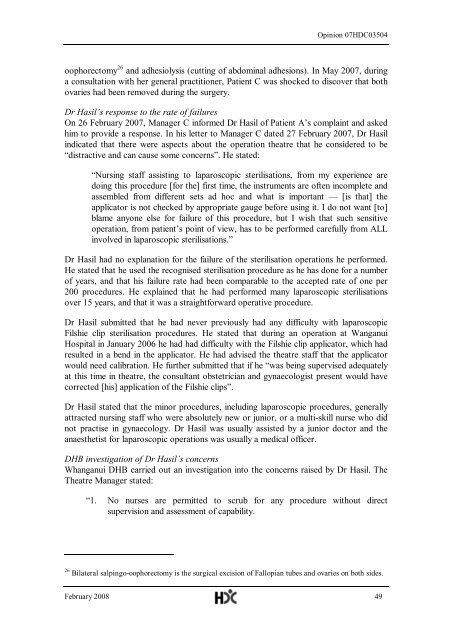Roman Hasil and the Whanganui DHB - Health and Disability ...
Roman Hasil and the Whanganui DHB - Health and Disability ...
Roman Hasil and the Whanganui DHB - Health and Disability ...
You also want an ePaper? Increase the reach of your titles
YUMPU automatically turns print PDFs into web optimized ePapers that Google loves.
Opinion 07HDC03504<br />
oophorectomy 26 <strong>and</strong> adhesiolysis (cutting of abdominal adhesions). In May 2007, during<br />
a consultation with her general practitioner, Patient C was shocked to discover that both<br />
ovaries had been removed during <strong>the</strong> surgery.<br />
Dr <strong>Hasil</strong>’s response to <strong>the</strong> rate of failures<br />
On 26 February 2007, Manager C informed Dr <strong>Hasil</strong> of Patient A’s complaint <strong>and</strong> asked<br />
him to provide a response. In his letter to Manager C dated 27 February 2007, Dr <strong>Hasil</strong><br />
indicated that <strong>the</strong>re were aspects about <strong>the</strong> operation <strong>the</strong>atre that he considered to be<br />
“distractive <strong>and</strong> can cause some concerns”. He stated:<br />
“Nursing staff assisting to laparoscopic sterilisations, from my experience are<br />
doing this procedure [for <strong>the</strong>] first time, <strong>the</strong> instruments are often incomplete <strong>and</strong><br />
assembled from different sets ad hoc <strong>and</strong> what is important — [is that] <strong>the</strong><br />
applicator is not checked by appropriate gauge before using it. I do not want [to]<br />
blame anyone else for failure of this procedure, but I wish that such sensitive<br />
operation, from patient’s point of view, has to be performed carefully from ALL<br />
involved in laparoscopic sterilisations.”<br />
Dr <strong>Hasil</strong> had no explanation for <strong>the</strong> failure of <strong>the</strong> sterilisation operations he performed.<br />
He stated that he used <strong>the</strong> recognised sterilisation procedure as he has done for a number<br />
of years, <strong>and</strong> that his failure rate had been comparable to <strong>the</strong> accepted rate of one per<br />
200 procedures. He explained that he had performed many laparoscopic sterilisations<br />
over 15 years, <strong>and</strong> that it was a straightforward operative procedure.<br />
Dr <strong>Hasil</strong> submitted that he had never previously had any difficulty with laparoscopic<br />
Filshie clip sterilisation procedures. He stated that during an operation at Wanganui<br />
Hospital in January 2006 he had had difficulty with <strong>the</strong> Filshie clip applicator, which had<br />
resulted in a bend in <strong>the</strong> applicator. He had advised <strong>the</strong> <strong>the</strong>atre staff that <strong>the</strong> applicator<br />
would need calibration. He fur<strong>the</strong>r submitted that if he “was being supervised adequately<br />
at this time in <strong>the</strong>atre, <strong>the</strong> consultant obstetrician <strong>and</strong> gynaecologist present would have<br />
corrected [his] application of <strong>the</strong> Filshie clips”.<br />
Dr <strong>Hasil</strong> stated that <strong>the</strong> minor procedures, including laparoscopic procedures, generally<br />
attracted nursing staff who were absolutely new or junior, or a multi-skill nurse who did<br />
not practise in gynaecology. Dr <strong>Hasil</strong> was usually assisted by a junior doctor <strong>and</strong> <strong>the</strong><br />
anaes<strong>the</strong>tist for laparoscopic operations was usually a medical officer.<br />
<strong>DHB</strong> investigation of Dr <strong>Hasil</strong>’s concerns<br />
<strong>Whanganui</strong> <strong>DHB</strong> carried out an investigation into <strong>the</strong> concerns raised by Dr <strong>Hasil</strong>. The<br />
Theatre Manager stated:<br />
“1. No nurses are permitted to scrub for any procedure without direct<br />
supervision <strong>and</strong> assessment of capability.<br />
26 Bilateral salpingo-oophorectomy is <strong>the</strong> surgical excision of Fallopian tubes <strong>and</strong> ovaries on both sides.<br />
February 2008 49

















